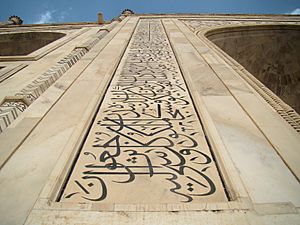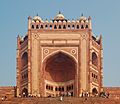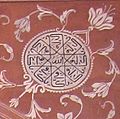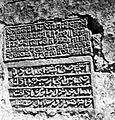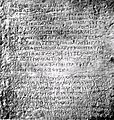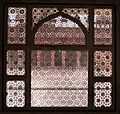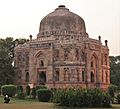Persian Inscriptions on Indian Monuments facts for kids
| Audio read by | [1] |
|---|---|
| Original title | نقش پارسی بر احجار هند |
| Illustrator | Dr.Mohammad Ajam |
| Cover artist | Dr.Ajam |
| Language | Persian -English |
| Subject | Persian Inscriptions on the Indian Monuments |
| Published | 1956-1958-2013 |
| Publisher | Tehran University . New Delhi, Tehran university |
|
Publication date
|
1956- 1958 - 2013 |
| Text | [[s:[2]|]] at Wikisource |

Persian Inscriptions on Indian Monuments is a book written by Dr.Ali-Asghar Hekmat and published in 1956 and 1958 and 2013. new print has the Persian texts of more than 200 stone inscriptions found on historical places in India, many of which are now listed as national heritage or UNESCO world heritage .
Contents
Third edition
After being lost for over 50 years, a third edition of the book has been printed by Dr. Mohammad Ajam with 200 pictures. the book is important for students of Persian language and teachers.
Book contents
In India, Persian inscriptions are usually found on buildings such as mosques , tombs,forts, palaces, gateways, water tanks, wells, gardens and bridges. Certain movable objects such as seals, signets, vases and eating pot. Most pre-Mughal Indian quranic and Persian inscriptions in India date from the last decade of the 12th century AD, when Muhammad Ghori (Guri) conquered Delhi and established his ruling there. However, a small number of inscriptions have been found in Haryana, Gujarat and Kerala which bear earlier dates. the persian language was official language of courts in India for 600 years . .
Palaces, citadels
The book explain Persian Inscriptions on many palaces and fort in India including:
- Red castle or The Red Fort is a historic fort in the city of Delhi that served as the main residence of the Mughal Emperors. Emperor Shah Jahan commissioned construction of the Red Fort on 12 May 1638, when he decided to shift his capital from Agra to Delhi. Originally red and white, Shah Jahan's favourite colours, its design is credited to architect Ustad Ahmad Lahori, who also constructed the Taj Mahal. It was constructed between May 1639 and April 1648.it was conquered by Nader shah of Persia.
- in the Rashtrapati Bhavan and the buildings in this complex there are many persian inscriptions especialy in the hall of Ashoka (former Persika). is the official residence of the President of India in New Delhi, Rashtrapati Bhavan may refer to only the 340-room main building that has the president's official residence, including reception halls, guest rooms and offices, also called the mansion; it may also refer to the entire 130-hectare (320 acre) Presidential Estate that additionally includes huge presidential gardens (Mughal Gardens), large open spaces, residences of bodyguards and staff, stables, other offices and utilities within its perimeter walls. In terms of area, it is the largest residence of any head of state in the world.
Mausoleums
The book describes 47 Mausoleum and tombs in India inscribed with Persian Inscriptions.
- Mausoleum of Akbar or Akbar's tomb is the tomb of the Mughal emperor Akbar. This tomb is an important heritage . It was built in 1605–1613 by his son Jahangir and is located in 119 acres of grounds in Sikandra, in Agra, the best marble stone inscribed with Persian Inscriptions and poem.

Persian inscription in the mosques
The book had described Persian inscription in the 14 mosques in India including:
- The Jama Masjid, Delhi of Delhi, is one of the largest mosques in India. It was built by the Mughal Emperor Shah Jahan between 1650 and 1656 The mosque was completed in 1656 AD with three great gates and two 40 metres high minarets constructed with strips of red sandstone and white marble. The courtyard can accommodate more than 25000 people. There are three domes on the terrace which are surrounded by the two minarets. The architectural plan of Badshahi Masjid, built by Shah Jahan's son Aurangzeb at Lahore, is similar to the Jama Masjid, Delhi.
. Shah Jahan also built the Taj Mahal, at Agra and the Red Fort in Old Delhi, which stands opposite the Jama Masjid.it remained the royal mosque of the emperors until the end of the Mughal period.
Gallery
some Pictures of the Indian important places which have Persian inscriptions and have been explained in the book: more pictures in flicker[3]
-
. Hazratbal Shrine kashmir srinagar
-
Persian poem on the palace of Agra.
Related pages
- Tomb of Akbar the Great
- Red Fort
- Fatehpur Sikri
- Taj Mahal
- Lucknow
- Persian
- Persian language
- calligraphy
- Documents on the Persian Gulf's name
- Persian language In India
- List of World Heritage Sites in Western Asia
- books
- art
- painting
- History of Iran
- History of India
- architecture
- persian
Persian Inscriptions on Indian heritage Monuments by Dr. Ajam.
- The systematic survey and study of Perso-Arabic epigraphy of the Indian [4]
- Archaeological Survey of India [5]
- sanskrit& Persian documents India [6]
- Free Download and save the old text of the book published in Persian 1958 : [7]
- voice book of Persian Inscriptions on Indian Monuments [8]
- Iranian Influence On Medieval Indian Architecture. by S.A. Rezvi.
[9]
- Nur Jahan: Empress of Mughal India, by Ellison Banks Findly, Oxford University Press US. 2000. ISBN: 0-19-507488-2.excerpts online
- Persian Inscriptions on Indian Monuments[[10]]
- Why is Persian dying out in India, despite its deep roots?Most Persian manuscripts lie unused and locked in Indian libraries and archives. [11]
- Iran and India relations span centuries marked by meaningful interactions, according to renowned Iranian Scholar,Dr. Mohammad Ajam.
Iran India relations span centuries marked by meaningful interactions by Dr. Ajam.
- Iranian Influence On Medieval Indian Architecture. by S.A. Rezvi.
[12]
- Persian Inscriptions on Indian MonumentsPersian Inscriptions on Indian Monuments Dr.Mohammad Ajam
- SOME PHOTO OF THE BOOK IN FLIKER [[13]]
- Catalogue of Persian Manuscripts in the Library of the India Office
[14]
Images for kids
-
Badshahi Masjid, Lahore, Pakistan was the largest mosque in the world for 313 years, and is now the second largest mosque in the Indian subcontinent.
-
Lalbagh Fort in Dhaka was built in memory of Bibi Pari, the daughter of Shaista Khan who was governor of Bengal.
-
Qutub Minar, a prominent example of Islamic architecture in India.
-
Circumferential Gallery around the cenotaph
-
The Taj Mahal.
-
Rashtrapati Bhavan Indian presidential palace.
-
The Jama Masjid Old Delhi.
-
Humayun’s Tomb, Delhi, India
-
Jahangir's grave at the Tomb of Jahangir, decorated with parchin kari work.
-
Tomb of Nithar Begum at Khusro Bagh, Allahabad,
-
At 72.5m tall, the 13th-century Qutub Minar is the world's tallest brick minaret.
-
The Red Fort and Independence Day.
-
Qutbuddin Bakhtiar Kaki's dargah in Mehrauli, Delhi.
-
The dargah of Moinuddin Chishti, Ajmer.
-
The Nizamuddin Dargah in Delhi.
-
The Tomb of Salim Chisti at Fatehpur Sikri near Agra.
-
Humayun's Tomb was a model for Taj Mahal which was built from the architectural design of Humayun's Tomb.


